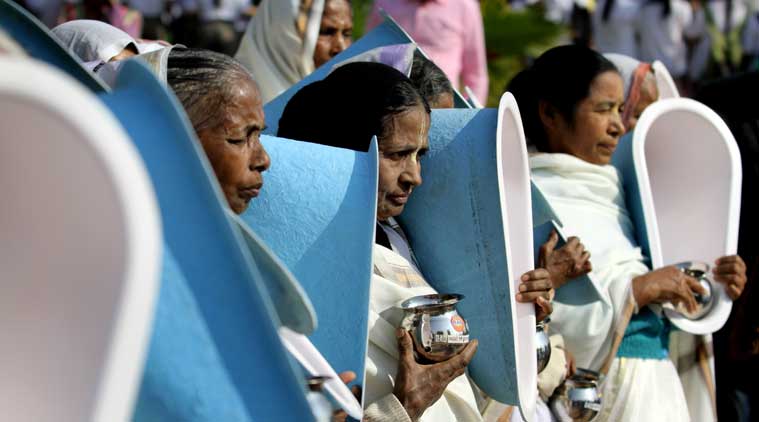- India
- International
Public hospital toilets: A hotbed of infections
About 30 per cent of Mumbai’s 12 million people use these 30 public hospitals.
 Widows from Vrindavan hold toilet pots at the International Toilet festival to mark the World Toilet day organised by Sulabh International at Central park, Cannaught place in New Delhi on Nov 18th 2014. (Source: Express photo by Ravi Kanojia)
Widows from Vrindavan hold toilet pots at the International Toilet festival to mark the World Toilet day organised by Sulabh International at Central park, Cannaught place in New Delhi on Nov 18th 2014. (Source: Express photo by Ravi Kanojia)
“It’s so dirty. How do people use these hospital toilets without complaining?” an amazed student from Switzerland, Anita Rohner, asks after visiting the city’s largest civic-run KEM Hospital. Rohner is writing her thesis on Mumbai’s incredibly under-pressure public health infrastructure.
There are four state-run and 26 hospitals under the Brihanmumbai Municipal Corporation (BMC) in Mumbai. About 30 per cent of Mumbai’s 12 million people use these public hospitals. While availability of toilets is not an issue in any of these hospitals, maintenance is a big challenge.
On his wobbly legs, 65-year-old Zainuddin Hamza used to clean the Dr R N Cooper Hospital’s sixth-floor bathroom daily before he bathed there. Admitted for 23 days with a lung infection, he says, “I’m too weak to pour bucketfuls of water in the dirty bathroom now. So I haven’t bathed for a week.”
While the bathroom is cleaned twice, sometimes three times, in a day, he complains that it gets dirty within an hour of cleaning and actually needs round-the-clock maintenance.
The refurbished Cooper Hospital was inaugurated in November last year. But within the first year itself, there are broken taps in the toilets, says another patient, Sampa Yadav.

At KEM hospital, which sees 6,000 patients every day, visitors and staffers walk with their nose tightly covered in the casualty ward’s corridor where a stinking washroom stands. Sunita Masavkar, nine months pregnant and admitted there on Wednesday, treads carefully on the greasy floor only to find one western commode filled with faeces and another Indian toilet clogged with plastic bottles in the casualty ward’s common toilet. “I could’ve slipped on the wet floor . I can’t pee in such a place,” she says, walking slowly back to her bed.
Hospital toilets, one would imagine, need to be disinfected several times in the day. According to Dr Suvin Shetty, pathologist attached with L H Hiranandani Hospital, a gram negative bacilli usually present in toilets can infect the intestine or weaker organs of humans if they get a passage to enter. “These pathogenic infections can easily happen in washrooms that are not cleaned with disinfectants. In private hospitals, washrooms are disinfected before being used. This issue should be seriously focussed upon in public hospitals.”
Leptospirosis is another disease that can spread through infected urine. A resident doctor at KEM Hospital says, “The infected urine can affect another patient who is already low on immunity. Waterlogged toilets pose a high risk of leptospirosis infection.”
While the condition of toilets allotted to staffers, nurses and doctors is relatively better, these are sometimes locked to prevent patients and others from entering.
At JJ hospital, where the out-patient department witnesses an inflow of 1,500 patients on a daily basis, the toilets are invariably dirty. Shama Usmaan, from Bhiwandi, says, “I check all the cubicles and use the least dirty one. But the stench is so strong that I try to relieve myself quickly.”
In tertiary-care Sion Hospital, the OPD department has a long queue outside the lone toilet that acts as a urine sample collection point for patients requiring medical tests. “It stinks all the time even after getting cleaned. People just come in with a bottle for urine collection and leave. In an hour, hundreds of people visit the toilet,” said Rachel D’Silva, attached with NGO Observer Research Foundation.
In almost all public hospitals, cleaners are given a bottle of phenyl. A cleaner in KEM hospital said they just mop the floors.
While public hospitals are struggling to maintain cleanliness in toilets, cleaners and sweepers blame lack of civic sense in people for the current state of public toilets. Certain toilets that the Newsline visited were infested with cockroaches and few others had over-flowing dustbins inside the washroom passages.
While the Swachh Bharat Abhiyaan, kicked off three months ago, saw pompous involvement of doctors and deans from all hospitals, the sweeping and mopping was just a one-day show, allege several class III and IV employees.
“The doctors cleaned the hospital for one day and forgot all about it the next day. We need more staff to keep the hospital clean as we are already over-burdened. Only then can the toilets be kept clean,” said a cleaner from JJ hospital.
tabassum.barnagarwala@expressindia.com
Apr 19: Latest News
- 01
- 02
- 03
- 04
- 05






































